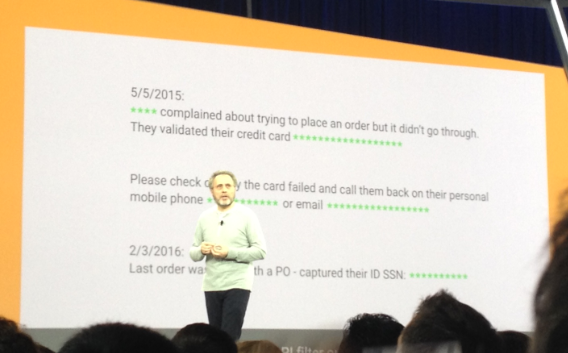Google Drives Into The Business Content Services Segment of ECM
Several Forrester colleagues and I attended the Google Next conference earlier this month, an event showcasing the Google Cloud Platform portfolio. One message, however, was distinctly NOT cloudy: Google is aiming at the enterprise market. And that includes your enterprise content.
Google Drive has been a popular offering in the cloud enterprise file sync and share market, and we evaluated it as a Leader in our 2016 Forrester Wave (subscription required). The entire G Suite application portfolio, which includes Google Drive, is now under the G Cloud line of business, an enterprise-focused team under the leadership of industry veteran (and Alphabet board member), Diane Green.
I attended sessions and spoke one-on-one with a few of the key product experts behind Google Drive. This team articulated a commitment to hear, understand, and react to the unique requirements of enterprises. This means further transparency and more rigor around roadmaps, requirements, and pace of release. Google must now find the right balance between serving the needs of large commercial customers — without losing the spirit of engineering innovation for which they are noted.
Just like other cloud-based file sharing vendors with roots in the consumer or personal productivity market, Google has added a set of features and extended capabilities designed specifically for businesses. These are not necessarily sexy enhancements, but they will keep Google Drive on the short list for a larger set of customers. Data loss prevention, governance, retention policies, legal holds? These don’t seem like cutting-edge capabilities to tech managers familiar with ECM technologies, but they’re essential to let Google Drive be viewed as a credible replacement for on-premises file stores and content repositories.
Here are the key announcements I found most relevant to my enterprise content management and file sync and share research area
- Sensitive data detection. Google’s DLP (data loss prevention) API allows organizations to scan and detect for over 40 pre-configured sensitive data types, including several national government identifiers such as US Social Security Numbers, Canadian Social Insurance Numbers. The automated redaction or masking services was particularly intriguing, applying a visual mask on these personally-identifiable information types in the context of a chat or document. (see below)

- Stewardship of content that scales beyond individual users. This is a key indicator of the enterprise commitment: shifting the administrative and permission model to ensure documents are managed by the enterprise and not only individuals. People shift roles, leave the organization, join new projects all the time.- A document control model that ties document stewardship to business-defined roles – and not the creator – is a key step toward competing for more opportunities in the business content services segment of ECM. Google has opened up an early adopter program for customers to test its “Drive File Stream” capability, which will allow more on-demand access to cloud-stored files, without requiring sync to a desktop/laptop device first, essentially behaving like a traditional network drive.
- Retention, deletion, legal holds, and archiving policies. Over the last year Google has worked to re-architect its Vault offering and extend it beyond email. Vault now supports documents and files stored in Google Drive. This is an important step to reposition Drive as a “system of record” for enterprise content that needs to be securely disposed of in line with records management policies. Retention rules can also ensure that information is kept – and can’t be removed – for a period of time. For example, documents covered by tax laws that must be retained for at least 7 years. Legal holds can be applied to Google Drive content, ensuring that any electronically stored information that may be relevant to a current or pending investigation (such as eDiscovery, freedom of information, audits, etc.) is not altered or deleted.
- Intelligence content services for image, photo and (soon) video recognition. Google Drive has had embedded OCR support for some time, allowing search of images, jpgs, or PDFs within seconds. The Vision API takes this recognition service to digital photos, identifying key objects colors, places and enriching the document with these tags. The still-beta Video Intelligence API extends this image recognition into videos, offering the potential to search for a particular scene using natural language, and being directed to the moment where the image is present – even if there is no inherent text or metadata. (see below)

- Acquisition of dedicated migration expertise to move enterprise content into the cloud. Perhaps the most intriguing announcement by the G Suite team was the acquisition of Vancouver-based migration technology company AppBridge. AppBridge has a number of connectors to fast-track migration to G Drive from competitive cloud content platforms, as well as on-premises systems and file shares. I had a chance to talk with CEO Cameron Wallin, in order to learn more about their transformation suite, including a surveyor module (pre-migration scan/analysis tool to determine migration scope and sources) and the transformer tool (to map metadata and perform the migrations). In my opinion, there are opportunities to further enhance the current AppBridge offering include deeper pre-migration analytics, to help identify files containing sensitive data (such as personally-identifiable information). This would benefit companies that may choose to keep such data in-house due to policies or legal/regulatory requirements. Deeper integration with Google’s broader set of DLP and other content APIs would certainly be a logical next step.
What it means
A new cloud-native content platform has entered the business content services segment of ECM. Organizations already looking at cloud for content storage, file sharing, basic library services could consider Google Drive. It, like Box and Dropbox before it, is transitioning from the consumer-focused file sync and share market to an enterprise-focused modern content platform
